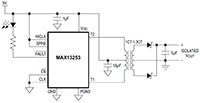 Analog Devices' MAX13253 is a 1 A push-pull transformer driver designed to provide a simple solution for low-EMI isolated power supplies. The MAX13253 has an internal oscillator and operates from a single +3.0V to +5.5V supply. The transformer’s secondary-to-primary winding ratio defines the output voltage, allowing selection of virtually any isolated output voltage with galvanic isolation. The MAX13253 features an integrated oscillator driving a pair of N-channel power switches. The driver includes pin-selectable spread-spectrum oscillation and a well-controlled slew rate to reduce EMI. The MAX13253 can optionally be driven by an external clock to further manage EMI. Internal circuitry guarantees a fixed 50% duty cycle to prevent DC current flow through the transformer, regardless of which clock source is used. The MAX13253 operates with up to 1 A of continuous current and features integrated protection including fault detection, overcurrent protection, and thermal shutdown. The MAX13253 includes a low-current shutdown mode to reduce the overall supply current to less than 5 µA (max) when the driver is disabled. The MAX13253 is available in a small, 10-pin, (3 mm x 3 mm) TDFN package and is specified over the -40°C to +125°C temperature range.
Analog Devices' MAX13253 is a 1 A push-pull transformer driver designed to provide a simple solution for low-EMI isolated power supplies. The MAX13253 has an internal oscillator and operates from a single +3.0V to +5.5V supply. The transformer’s secondary-to-primary winding ratio defines the output voltage, allowing selection of virtually any isolated output voltage with galvanic isolation. The MAX13253 features an integrated oscillator driving a pair of N-channel power switches. The driver includes pin-selectable spread-spectrum oscillation and a well-controlled slew rate to reduce EMI. The MAX13253 can optionally be driven by an external clock to further manage EMI. Internal circuitry guarantees a fixed 50% duty cycle to prevent DC current flow through the transformer, regardless of which clock source is used. The MAX13253 operates with up to 1 A of continuous current and features integrated protection including fault detection, overcurrent protection, and thermal shutdown. The MAX13253 includes a low-current shutdown mode to reduce the overall supply current to less than 5 µA (max) when the driver is disabled. The MAX13253 is available in a small, 10-pin, (3 mm x 3 mm) TDFN package and is specified over the -40°C to +125°C temperature range.
| Features and Benefits |
|
|
- Simple, flexible design
- 3.0 V to 5.5 V supply range
- Low RON 300 mΩ (max.) at 4.5 V
- Up to 90% efficiency
- Provides up to 1 A to the transformer
- Internal or external clock source
- Internal oscillator frequency: 250 kHz or 600 kHz
|
|
- Optional spread-spectrum oscillation
- -40°C to 125°C temperature range
- Integrated system protection
- Fault detection and indication
- Over-current limiting
- Under-voltage lockout
- Thermal shutdown
|
 Analog Devices' MAX13253 is a 1 A push-pull transformer driver designed to provide a simple solution for low-EMI isolated power supplies. The MAX13253 has an internal oscillator and operates from a single +3.0V to +5.5V supply. The transformer’s secondary-to-primary winding ratio defines the output voltage, allowing selection of virtually any isolated output voltage with galvanic isolation. The MAX13253 features an integrated oscillator driving a pair of N-channel power switches. The driver includes pin-selectable spread-spectrum oscillation and a well-controlled slew rate to reduce EMI. The MAX13253 can optionally be driven by an external clock to further manage EMI. Internal circuitry guarantees a fixed 50% duty cycle to prevent DC current flow through the transformer, regardless of which clock source is used. The MAX13253 operates with up to 1 A of continuous current and features integrated protection including fault detection, overcurrent protection, and thermal shutdown. The MAX13253 includes a low-current shutdown mode to reduce the overall supply current to less than 5 µA (max) when the driver is disabled. The MAX13253 is available in a small, 10-pin, (3 mm x 3 mm) TDFN package and is specified over the -40°C to +125°C temperature range.
Analog Devices' MAX13253 is a 1 A push-pull transformer driver designed to provide a simple solution for low-EMI isolated power supplies. The MAX13253 has an internal oscillator and operates from a single +3.0V to +5.5V supply. The transformer’s secondary-to-primary winding ratio defines the output voltage, allowing selection of virtually any isolated output voltage with galvanic isolation. The MAX13253 features an integrated oscillator driving a pair of N-channel power switches. The driver includes pin-selectable spread-spectrum oscillation and a well-controlled slew rate to reduce EMI. The MAX13253 can optionally be driven by an external clock to further manage EMI. Internal circuitry guarantees a fixed 50% duty cycle to prevent DC current flow through the transformer, regardless of which clock source is used. The MAX13253 operates with up to 1 A of continuous current and features integrated protection including fault detection, overcurrent protection, and thermal shutdown. The MAX13253 includes a low-current shutdown mode to reduce the overall supply current to less than 5 µA (max) when the driver is disabled. The MAX13253 is available in a small, 10-pin, (3 mm x 3 mm) TDFN package and is specified over the -40°C to +125°C temperature range.









